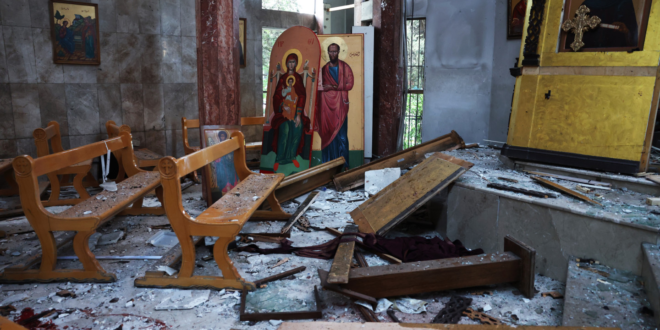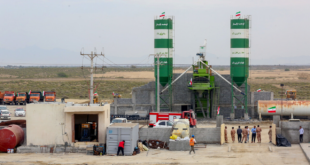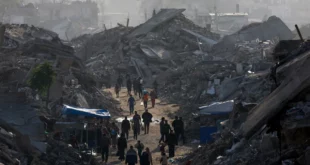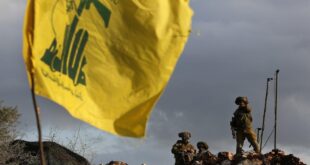“Our churches are our homes,” says Mark, 26, standing amid the shattered glass and blackened walls of the St. Elias Church. “We were raised in these churches, but there are children who will never be able to grow up here as we did.”
He speaks softly, his voice barely heard above the churning chaos around him. Sirens wail, as armed men pile out of pick-up trucks and residents, some wrapped in bandages, speak frantically to distraught relatives on the phone.
On Sunday, a masked man opened fire on a packed congregation attending Sunday Mass at St Elias Church in the neighbourhood of Dweila in Damascus before exploding a suicide vest, killing at least 25, according to the latest figures from the Syrian Ministry of Health.
Inside the church, rescuers from Syria’s White Helmets and the local community worked under the visage of blood-spattered icons to clear aside debris and blackened pews in order to collect the scattered remains of those killed in the bombing.
Walid Bizree, 62, stands pale-faced and statue-like at the edge of a scrum of concerned locals, civil defence and security services all pushing to get inside the already crowded church. “My grandson was here but I couldn’t find him,” he tells The New Arab. “I prayed in my heart that nothing had happened to him.”
Bizree’s grandson had been lucky. “His mum called me to say that, thank God, he came back – he was fine.” He had been sitting just outside the church at the time of the attack.
“By God, he killed so many,” he laments. “No one can control someone like this. This is not Syria. This is the blood of a criminal.”
A resurgent Islamic State
Syria’s Ministry of the Interior issued a statement soon after the attack, attributing responsibility to the Islamic State for the bombing and subsequently carried out security operations in the suburbs of Damascus targeting individuals supposedly behind the attack.
According to UN estimates, the Islamic State has between 1,500-3,000 fighters across Syria and Iraq. Syrian security services have thwarted a number of attempted attacks in recent weeks, but the threat from the Islamic State has been growing.
“Unfortunately, we have been expecting an attack like this for quite some time,” Nanar Hawach, a Senior Syria Analyst with International Crisis Group, told TNA. “It has been a question of when not if.”
The Islamic State has been “rebuilding its capacity by trying to increase its manpower and access to weaponry since the fall of the regime”, he explains.
In recent weeks, the Islamic State has reportedly been repositioning its cells from desert regions in the east of the country towards the cities.
“This appears to signal that they were shifting towards a more offensive position,” argues Hawach. At the end of May, the Islamic State carried out its first attack on Syria’s new security services in the southern region of Suweida, killing one and injuring three.
“I imagine we will see more attacks in the future,” predicts Hawach. “They’re hoping to draw in hostile reprisals from the authorities in order to attract potential recruits, both foreign and domestic.”
For Mark, standing amongst the smell of decay and destruction, this feels eerily familiar.
“This happened before in Iraq, it’s happening now in Syria.” Iraq’s Christians were heavily targeted by Islamist insurgents following the 2003 US-led invasion – their population declined precipitously from 1.5 million to just a few hundred thousand as many fled en masse.
“This is right out of Zarqawi’s playbook,” explains Tam Hussein, an award-winning investigative journalist and co-author of ‘To the Mountains: My Life in Jihad, From Algeria to Afghanistan’, referencing Abu Musab Al-Zarqawi, the former leader of Al-Qaeda in Iraq, which later developed into the Islamic State.
Zarqawi was responsible for transforming an anti-American insurgency following the 2003 invasion into a sectarian civil war by launching attacks against Iraq’s Shia population, alongside a number of minority groups, including Christians.
“They are intending to spark sectarian unease,” he told TNA. “By undermining faith within Syria’s minority groups that the new government can protect them, whilst delegitimising them in the eyes of the international community.”
However, the Islamic State is still incredibly weak in comparison to its heyday in 2016, in which it ruled over an area approximately the size of the United Kingdom.
“They have the capacity to destabilise Syria,” says Hussein. “But we are very far from seeing any territorial takeover like they were capable of previously.”
Ensuring the protection of minorities
Yet, this will be little solace to Syria’s Christian community, who lack any real means to protect themselves, and will “most likely respond as they always have in the face of sectarian violence in the region – by leaving,” believes Hussein.
“It feels like the civil war again,” Mark confesses. “Everyone is scared [more attacks] will happen.”
Mark was sent by his parents to Germany in 2014 at the height of the civil war after a rocket landed in his building. He returned to Syria in 2022 and had hoped that the fall of the Assad regime would finally bring some degree of peace.
“I think I’d like to go back to Germany now to be honest, but I don’t think the embassy would let me,” he says with a sad smile.
There are some pre-emptive policies that the Syrian government could adopt in order to deter and prevent further attacks. First, according to Hawach, any location where minorities gather is a potential target for radical Islamist elements, and so should receive heightened security protection.
Secondly, Syria’s security services – still overstretched – should put greater emphasis on developing a genuine security capacity, beyond just tokenistic shows of force.
Yet, importantly, Hawach stresses, developing Syria’s security apparatus isn’t simply a matter of capacity, because “some of their own policies have rendered them vulnerable – in particular, excluding minorities from the security services”.
He believes that the attack on St Elias church goes “beyond a simple security breach,” but reflects a failure of the security services to adequately take into account the concerns of the minorities.
Instead, Hawach suggests that ensuring the protection of minorities requires the security apparatus to be more actively embedded within minority communities, whilst those communities themselves take a central role in protecting themselves.
 Eurasia Press & News
Eurasia Press & News




